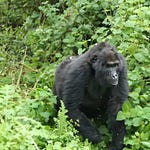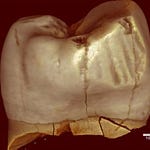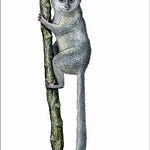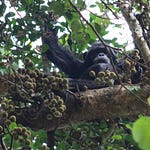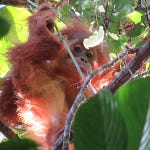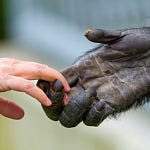The Echo in the Trees
In the dense forests of Guinea-Bissau, where humidity muffles footsteps and cicadas drone like power lines, something unexpected echoes through the undergrowth: the sharp crack of stone against wood. Not a geologic accident or a falling branch, but the deliberate act of a chimpanzee slamming a rock into a tree trunk—again and again.

This behavior, observed and analyzed by a team of primatologists led by Sem van Loon and colleagues from Wageningen University and the German Primate Research Center, is more than a curiosity. It's a puzzle piece in the study of animal culture and communication. Published in Biology Letters1 (2025), the research traces how chimpanzees may be using stones not only as tools but as instruments—augmenting their long-distance calls and creating soundscapes that mark space, identity, or even memory.
From Buttresses to Boulders
Chimpanzees (Pan troglodytes) are known to drum on hollow tree buttresses with their hands and feet, combining the percussive rhythms with vocalizations like pant-hoots and climax screams. These displays are often tied to dominance, group movement, or excitement. The behavior is well documented across multiple populations, functioning as a kind of forest broadcast system.
But the “stone-assisted drumming” documented in Boé, southeastern Guinea-Bissau, is something different.
“Stone throwing at trees is performed along with clear long-distance communication and male display signaling behaviors,” the researchers noted.
Unlike traditional drumming, chimpanzees often pant-hooted before stone strikes, not after—a reversal of the usual pattern. They swayed less before the drumming and engaged less in vocal follow-up. This pattern suggests the motivation for the act might differ from foot or hand drumming. Stone-assisted drumming might serve a separate communicative function, possibly enhancing the sound’s range or its symbolic significance.
The Culture in the Crack
Among the most compelling findings: chimpanzees don’t always bring new stones. In 78% of recorded cases, they picked up rocks already lying at the base of trees, forming curious stone piles that persist across time. Earlier work labeled this “accumulative stone throwing,” but van Loon’s team argues that the term stone-assisted drumming more accurately reflects the act’s communicative purpose.
“This behavior has its own signal value, separate from hand and foot buttress drumming,” the study reports. “Considering the spatial variation, it might be culturally transmitted.”
The idea of chimpanzee culture is no longer controversial. Groups across Africa exhibit distinct tool-use traditions—nut-cracking in West Africa, spear-fishing for bush babies in the savannahs of Fongoli. But stone-assisted drumming presents a rare case where tools appear to be used for communication, not food procurement.
A Learned Beat?
The researchers observed that young chimpanzees also engaged in stone-assisted drumming, suggesting that the behavior is learned socially. It's a hallmark of cultural transmission. Add to this the fact that not all populations drum in the same way—or at all—and a picture emerges of regional drumming dialects, each shaped by group tradition.
In this way, the study speaks not just to chimpanzees, but to us. The evolutionary bridge from sound to symbol, from rhythm to ritual, may not be uniquely human. It may echo back through the rainforest, in the clatter of stones.
“Variation among locations and individuals… supports the idea that the observed spatial differences have a culturally evolved component,” the study notes.
Tools for Talk, Not Just for Food
In evolutionary biology, tool use has often been studied in the context of problem-solving—how animals get food, crack nuts, dig termites. But this study shows that tools may also play a role in something even more ancient and ethereal: the need to be heard.
Stones, thrown or slammed, produce low-frequency sounds that travel farther in the forest. That acoustic advantage might make them ideal for long-range signaling in densely vegetated environments. It’s not difficult to imagine a male chimpanzee launching a stone at a resonant tree to announce his presence to rivals—or potential mates—miles away.
The Rhythm Remains
Chimpanzees aren’t making music, at least not in the human sense. But their rhythmic engagement with the environment—deliberate, patterned, socially transmitted—is a reminder that the seeds of culture and communication are old. Possibly millions of years old.
And sometimes, it all starts with a rock and a tree.
Related Research
Kühl, H. S., et al. (2016). Chimpanzee accumulative stone throwing. Scientific Reports, 6, 22219. https://doi.org/10.1038/srep22219
– A foundational study documenting the phenomenon of chimpanzees throwing stones at tree trunks and forming mysterious piles.Kalan, A. K., et al. (2019). Chimpanzees use tree species with a resonant timbre for accumulative stone throwing. Biology Letters, 15(7), 20190747. https://doi.org/10.1098/rsbl.2019.0747
– Explores acoustic properties of trees chosen for stone throwing, linking behavior to long-distance signaling.Wilhelm, W., et al. (2025). Selectivity in buttress drumming tree properties among chimpanzees (Pan troglodytes schweinfurthii) of the Waibira Community in Budongo Forest, Uganda. American Journal of Primatology, 87, e23712. https://doi.org/10.1002/ajp.23712
– Examines tree selection in drumming and possible links to communicative intent.Arcadi, A. C., Robert, D., & Boesch, C. (1998). Buttress drumming by wild chimpanzees: temporal patterning, phrase integration into loud calls, and preliminary evidence for individual distinctiveness. Primates, 39(4), 505–518. https://doi.org/10.1007/BF02557572
– One of the earliest analyses of how drumming may signal identity.Whiten, A., et al. (2005). Conformity to cultural norms of tool use in chimpanzees. Nature, 437(7059), 737–740. https://doi.org/10.1038/nature04047
– Demonstrates cultural variation in chimpanzee tool use, foundational for the study of social learning in primates.
van Loon, S., Heitkönig, I. M. A., Goedmakers, A., Mundry, R., & Naguib, M. (2025). Stone-assisted drumming in Western chimpanzees and its implications for communication and cultural transmission. Biology Letters, 21(5), 20250053. https://doi.org/10.1098/rsbl.2025.0053


